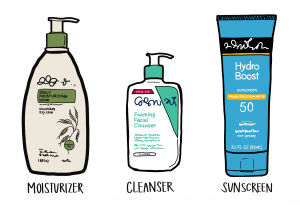Shakespeare once said that the eyes are the window to the soul. However, dermatologists and scientists might counter that by saying perhaps the skin is the window to the soul. Clear, smooth and rejuvenated skin is an indicator of healthy biological functions underneath–and a comprehensive skincare routine can help make all the difference in the health of one’s skin.
As the largest, yet often most underrated organ of the human body, the skin serves as the first line of defense against damaging external environmental conditions to protect the vital organs within. Visually, we’re familiar with the outermost layer of the skin, called the epidermis, which is partially composed of melanocytes that produce melanin to protect against the sun’s UV rays. The epidermis also contains lymphocytes that fight off germs by capturing and filtering them out through lymph nodes. In order to keep up with exposure to the outside world, lower layers of the epidermis constantly produce new skin cells. Eventually, these cells grow with age and are pushed up to the epidermal surface by newer cells, where they harden and create the tough, sealed boundary of the outermost skin.
Over time, however, the skin undergoes natural wear and tear and begins showing signs of internal aging. The impacts of battling the sun’s ultraviolet radiation on a daily basis slowly accumulate and cause the gradual loss of the intracellular structure of skin cells layers. This occurs through a decrease in the production of keratinocytes, which are cells that create the protein keratin that largely make up the rigid barrier of skin. Internal aging also reduces epidermal cell regeneration by breaking down the efficiency of the paracrine system, which is crucial for regulating local cell signaling for skin cell network development.
Of course, the internal aging of skin is also reflected in our external appearance. The natural toll of life, daily exposure to chemical pollution, and our own skincare habits (or lack thereof) are the primary reasons for our worries over deepening wrinkles and dull, dry skin.
While nobody can avoid the inevitable signs of aging, the powers of a good skincare routine can help delay its onset. Skincare generally promotes healthy skin through a clear, hydrated and smooth complexion. However, skincare routines are highly unique to each person’s skin since good health can appear different based on individual needs. However, with a plethora skincare products on the market, all claiming to rejuvenate, refresh, and reset your skin, it is difficult to know what an effective skincare routine actually looks like.
Skincare products contain vehicles that cause positive effects through biologically active ingredients that can alter the structure of the skin or function of the skin cells. For example, a lotion (vehicle) can moisturize (effect) through urea (its active ingredient). An effective skincare routine will target protection and prevention, as well as cleansing and moisturizing.

Of the mentioned methods, cleansing is a seemingly simple but incredibly important step in creating a healthy foundation for one’s skin. Cleansing enhances the skin’s surface by removing excess pollution, microorganisms and dead skin cells, revealing a fresh surface underneath. Key components of cleansing products include ‘surfactants,’ or surface active ingredients that lower the skin’s surface tension and help remove debris easier. Lowering surface tension of the skin allows for deeper permeability of the cleanser. Cleansers also generally include ingredients that target restoration of keratin. Furthermore, most effective cleansers are slightly acidic with a pH around 5-6, which has shown to promote the integrity of aged skin, reduce dry skin, and decrease sensitivity to infection and irritation. The acidic conditions help to improve the cohesion of keratinocytes and homeostasis of the epidermal barrier. While there are plenty of effective cleansers on the market, it is important to choose cleansers that come in an optimal vehicle for one’s own skin type. Research shows that oily skin types benefit most from gel-based cleansers and soap bars, which create a foaming action that helps to deep-cleanse and remove excess oil without over-drying the skin. On the other side of the spectrum, creams or lotions that lock in hydration are optimal for dry skin types that lack the ability to retain skin moisture.
After cleansing, moisturizing is the next step in protecting and reinforcing the skin’s barrier function. A good moisturizer contains moisture-retaining ingredients called humectant agents, which are hydrophilic, or ‘water-loving’ molecules. Humectants bind with water from the environment and the more hydrated lower epidermal layers. This helps them bring moisture up into the topmost layer of the epidermis that loses moisture the quickest. Moisturizing products seal in moisture through occlusive agents, molecules that sit on top of the skin and forms a protective layer that reduces water loss. Those with dry skin can benefit from lightweight moisturizers, such as gels, lotions and serums. Although using a moisturizer is counter-intuitive for oily skin, it’s important to remember the difference between oil and water–though the surface of your skin may be plentiful in a naturally-produced mixture of oils called sebum, your skin may still be deficient in hydration, which can exacerbate external aging.
Finally, a proper skincare routine is nothing without sunscreen. The active ingredients in sunscreen, including zinc oxide and avobenzone, reduce UV radiation damage to DNA in epidermal cells by reflecting UV rays before they reach the skin. The jury is still out on the ‘right’ amount of SPF, or sun protection factor, to choose in sunscreen. SPF refers to the sunscreen’s ability to prevent erythema, which we typically know as a painfully reddening sunburn. However, researchers agree that an SPF of 15 is the bare minimum. However, people with fair skin should be warned that, according to the Food and Drug Administration, the optimal SPF range for their skin lies between 30-50.
Cleanser, moisturizer, and sunscreen–a good skincare routine sounds simple enough, right? However, not every skincare product you see on the shelves of Sephora or Target actually does what it claims to do. Certain products can wreak havoc on the natural balance of your skin. Whether it is unnecessarily removing the natural fatty components of your skin, withholding excess water, or disrupting your skin’s pH with harmful acidic chemicals, some products do more harm than good. Knowing how to shop smart and conscientiously can vastly improve your skincare routine experience. A good rule of thumb is to check the ingredients label of your skincare product. Professionals recommend avoiding products with unnecessary fragrances that can introduce a host of potentially harmful chemicals to your skin. A comprehensive list of potentially harmful ingredients in skincare products can be found on the Environmental Working Group, a non-profit research organization which advocates for consumer awareness and helps to identify safer alternatives.
The key to healthy skin is no secret: by understanding the functions of your skin, and how the right skincare products for your unique skin type can facilitate these functions, you can take control of your skin’s appearance and aging.
Sources:
Illustrations by Hannah Abraham
https://www.ncbi.nlm.nih.gov/pmc/articles/PMC7146365/
https://www.ncbi.nlm.nih.gov/pmc/articles/PMC5172479/
